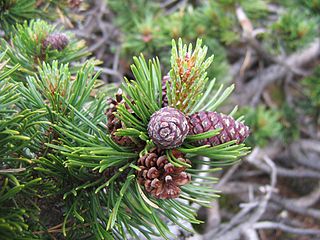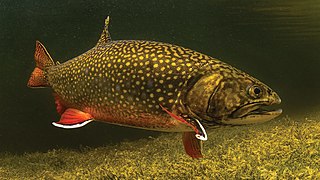
Pinus mugo, known as dwarf mountain pine, mountain pine, scrub mountain pine, Swiss mountain pine, bog pine, creeping pine, or mugo pine, is a species of conifer, native to high elevation habitats from southwestern to Central Europe and Southeast Europe.

The brook trout is a species of freshwater fish in the char genus Salvelinus of the salmon family Salmonidae native to Eastern North America in the United States and Canada. Two ecological forms of brook trout have been recognized by the US Forest Service. One ecological form is short-lived potamodromous populations in Lake Superior known as coaster trout or coasters. The second ecological form is the long-living predaceous anadromous populations which are found in northern lakes and coastal rivers from Long Island to Hudson Bay, which are referred to as salters. In parts of its range, it is also known as the eastern brook trout, speckled trout, brook char, squaretail, brookie, or mud trout, among others. Adult coaster brook trout are capable of reaching sizes over 2 feet in length and weigh up to 6.8 kg (15 lb), whereas adult salters average between 6 and 15 inches in length and weigh between 0.5 and 2.3 kg. The brook trout is characterized by its distinctive olive-green body with yellow and blue-rimmed red spots, white and black edged orange fins, and dorsal vermiculation. The diet of the brook trout is restrictive to the season and location of the fish, but will typically consist of terrestrial and aquatic insects, fry, crustaceans, zooplankton, and worms.

Salvelinus is a genus of salmonid fish often called char or charr; some species are called "trout". Salvelinus is a member of the subfamily Salmoninae within the family Salmonidae. The genus has a northern circumpolar distribution, and most of its members are typically cold-water fish that primarily inhabit fresh waters. Many species also migrate to the sea.

Roter Veltliner is a grape variety used to make white wine. It is found in Austria. Some of the better wines come from the Wagram district of Donauland.

Fontinalis is a genus of submerged aquatic mosses belonging to the subclass Bryidae. These mosses are also called willow moss, fountain moss, brook moss and water moss. The genus is widespread in the Northern Hemisphere and includes both species that occur in still water and in flowing water.

Nebria is a genus of ground beetles native to the Palearctic, the Near East and North Africa. There are more than 500 described species in Nebria.

Nebria livida is a species of ground beetle with two subspecies:

Xestia rhaetica is a moth of the family Noctuidae. It is found in northern Europe, central Fennoscandia, northern Russia and further east to Siberia. It is also present in the Tatra Mountains and the Bohemian Forest. In the Alps it is found on altitudes between 1,000 and 2,500 meters, but it is found at sea level in northern Europe. The species is also present in the Nearctic, including New York.

Nebriinae is a subfamily of ground beetles in the family Carabidae. There are about 12 genera and more than 840 described species in Nebriinae.
Neocrepidodera rhaetica is a species of flea beetle from Chrysomelidae family that can be found in Austria, France, Italy, Slovenia, Switzerland.
Nebria aetolica is a species of ground beetle in the Nebriinae subfamily that can be found in Albania, Greece, and North Macedonia.
Nebria germarii is a species of ground beetle in the Nebriinae subfamily that can be found in Austria, Germany, Italy, Liechtenstein, Switzerland, and in every state of former Yugoslavia, except for North Macedonia.
Nebria tatrica is a species of ground beetle in the Nebriinae subfamily that can be found in Poland Czech Republic and Slovakia.
Nebria fontinalis is a species of ground beetle in the Nebriinae subfamily that can be found in Italy and Switzerland.
Nebria fontinalis fontinalis is a subspecies of ground beetle in the Nebriinae subfamily that can be found in Italy and Switzerland.
Nebria cordicollis is a species of black coloured ground beetle from Nebriinae subfamily that can be found in Switzerland, Italy, and Germany. The species is about 5 millimetres (0.20 in) long.

Fontinalis antipyretica, greater water-moss, or common water moss, is a species of submerged aquatic moss belonging to the subclass Bryidae. It is found in both still and flowing freshwater in Europe, Asia, Greenland and Africa. In North America it is found in most Canadian provinces with a seaboard and most US states except the most southern.
Parvigondolella is an extinct genus of Late Triassic conodonts. The most common species in the genus, Parvigondolella andrusovi, is used as an index fossil for part of the Sevatian substage of the Norian stage. Kozur & Mock, 1991 named two additional species, P. rhaetica and P. vrielyncki. Moix et al. (2007) later argued that "Misikella" rhaetica was a species of Parvigondolella. In order to prevent having two different species with the same name within the genus, they renamed Kozur & Mock (1991)'s P. rhaetica to P. prorhaetica. However, this would be unnecessary if "Misikella" rhaetica was not related to Parvigondolella. Parvigondolella is typically considered a direct descendant of Mockina/Epigondolella bidentata.

Pinus × rhaetica, commonly known as Rhætic pine, is a natural hybrid of mountain pine and Scots pine. It is a coniferous tree nothospecies located in the subsection Pinus. The species name refers to the Rhætica alps, located in eastern Switzerland and western Austria.









